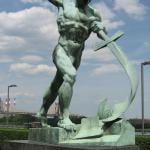For the next few days I am going to introduce you to a book that I’ve found to be a great resource. It’s called Hidden Worldviews: Eight Cultural Stories that Shape our Lives, by Wilkens and Sanford. The rest of the series can be read here.
 The sixth chapter reflects on scientific naturalism. This cultural story “holds that all that exists is physical and can be reduced to its elemental material composition” (100). Essentially it believes that matter is eternal, although it may have existed in various forms or essences. The authors clarify to say “it might be possible to say that the universe did not exist at some time billions of years in the past because matter was not then arranged in a manner that would be recognizable as ‘the universe’” (101). Because of these foundational beliefs about reality, naturalists reject the idea of God and see any appeal to a deity as a distraction from progress and human flourishing. In this worldview, “science” is “a form of salvation” (104). Certainly this sort of understanding of existence is incompatible with Christian faith. With that said, “Christians often react by rejecting science itself (sometimes with a rejection of rationality thrown in for good measure” (105). This response often ties together biological evolution and philosophical naturalism, which need not be the case. This is an over-reaction and not warranted by the biblical text.
The sixth chapter reflects on scientific naturalism. This cultural story “holds that all that exists is physical and can be reduced to its elemental material composition” (100). Essentially it believes that matter is eternal, although it may have existed in various forms or essences. The authors clarify to say “it might be possible to say that the universe did not exist at some time billions of years in the past because matter was not then arranged in a manner that would be recognizable as ‘the universe’” (101). Because of these foundational beliefs about reality, naturalists reject the idea of God and see any appeal to a deity as a distraction from progress and human flourishing. In this worldview, “science” is “a form of salvation” (104). Certainly this sort of understanding of existence is incompatible with Christian faith. With that said, “Christians often react by rejecting science itself (sometimes with a rejection of rationality thrown in for good measure” (105). This response often ties together biological evolution and philosophical naturalism, which need not be the case. This is an over-reaction and not warranted by the biblical text.
The seventh chapter explores the new age movement. This ideology borrows from Eastern sects and Western individualism. The idea of monism – the belief in “the unity of all things” (122) – stands as a foundational belief which expresses itself in two basic forms. The first, pantheism, “says that everything that exists is divine.” The second, panentheism, “agrees that all of nature is divine, but also says that an aspect of the divine exists beyond the universe. The Christian perspective is dualistic, according to the authors, that God is distinct from nature. The problem is that the dualism of creational monotheism has been distorted since the middle ages or prior. The split world of heaven and earth influenced by neo-platonic thought rendered a spirituality that attempts to disconnect from reality. True Christian spirituality finds the breath of God in every square inch of the world. It seems that had Christian theology and practice not been plagued by such a cosmological dualism, that the new age movement would not have been as necessary for those searching for a faith that matters here and now. Understanding how we relate to the earth certainly draws us toward asking questions of the nature of the universe.
The eighth chapter examined postmodern tribalism. This is a view that might have some connections to “moral relativism.” This sort of tribalism roots “a person’s real identity… in his or her cultural particularity.” Identity, therefore, cannot be captured in broad categories of identification such as “American” but must be narrowed down to specifics such as “ethnicity, gender, sexual orientation, or some other element.” Such people view themselves as underprivileged because of the dominant culture of white America and feel threatened by language games, seeing words as “competition for power” (141). Tribalism is emotionally fueled which gives rise to difficult tensions in today’s popular culture. I see this issue as one that invites the church into a posture of cultural humility and power-under approaches to society and politics. I also recognize that in evangelical culture, similar tribes are forming. Neo-reformed, Emergent, Progressive, Post-conservative, etc. are all examples of tribes dealing with power struggles for the future landscape of the church.











